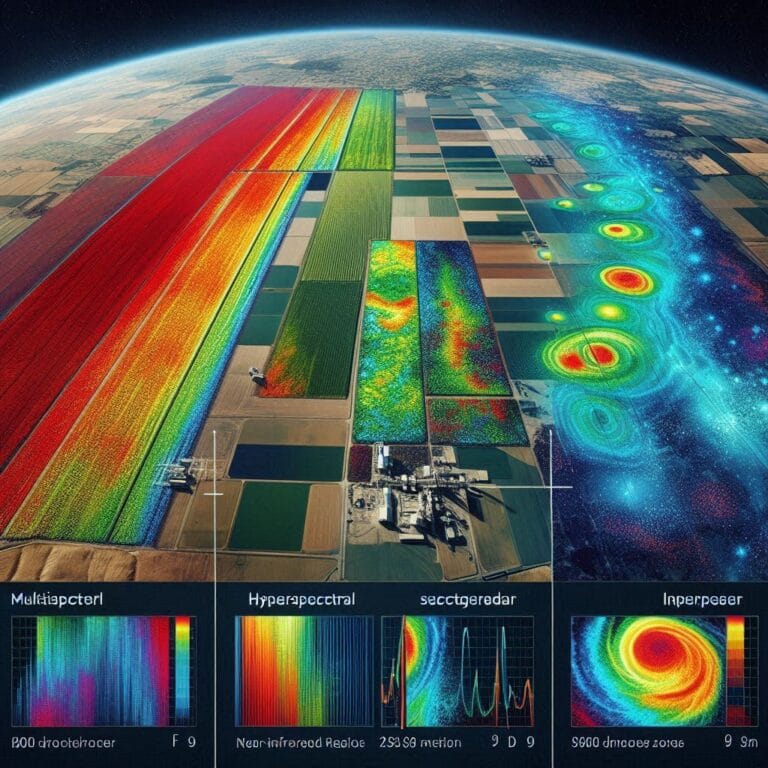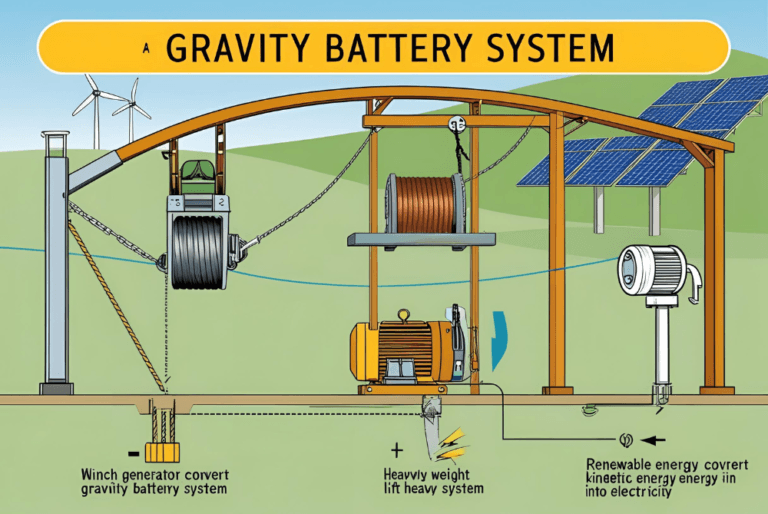What Are Bio-Integrated Electronics and Why Do They Matter?
Bio-integrated electronics represent a cutting-edge fusion of technology and biology, where electronic devices are designed to work harmoniously with biological systems. These devices enable seamless monitoring and interaction with living organisms and environments, offering transformative solutions for environmental monitoring electronics and other applications.

Defining Bio-Integrated Electronics
- Bio-integrated electronics are devices engineered with biocompatible electronic devices that can directly interface with biological systems without causing harm or rejection.
- These systems leverage materials and designs inspired by nature to achieve enhanced compatibility and functionality.
How Biology and Technology Intersect
- By embedding sensors, circuits, and systems into soft, flexible, and often biodegradable materials, sustainable biosensing technology creates devices capable of measuring environmental parameters such as air quality, water purity, and soil health.
- The fusion of biology and electronics provides real-time, precise data critical for managing pollution and fostering sustainability.
Significance for Environmental Monitoring
- Real-time monitoring through environmental monitoring electronics is essential for detecting and mitigating pollutants before they cause irreversible harm.
- These technologies support global sustainability efforts by providing actionable insights into air, water, and soil quality, which are vital for public health and ecological balance.
How Bio-Integrated Electronics Work
The functionality of bio-integrated electronics relies on the synergy between advanced electronic materials and biological systems, allowing for real-time environmental sensing and interaction.
Key Components and Their Roles
- Flexible and Organic Electronics
- These devices utilize flexible electronics environmental sensing to adapt seamlessly to irregular surfaces, making them ideal for integrating with biological tissues or uneven environmental terrains.
- Organic electronics for biosensing employ materials like conductive polymers, which are lightweight, bendable, and environmentally friendly.
- Sensor Integration
- Sensors embedded in these devices measure critical parameters such as temperature, pH, humidity, and pollutant levels.
- Their biocompatibility ensures they can operate effectively in contact with biological tissues or delicate environmental settings.
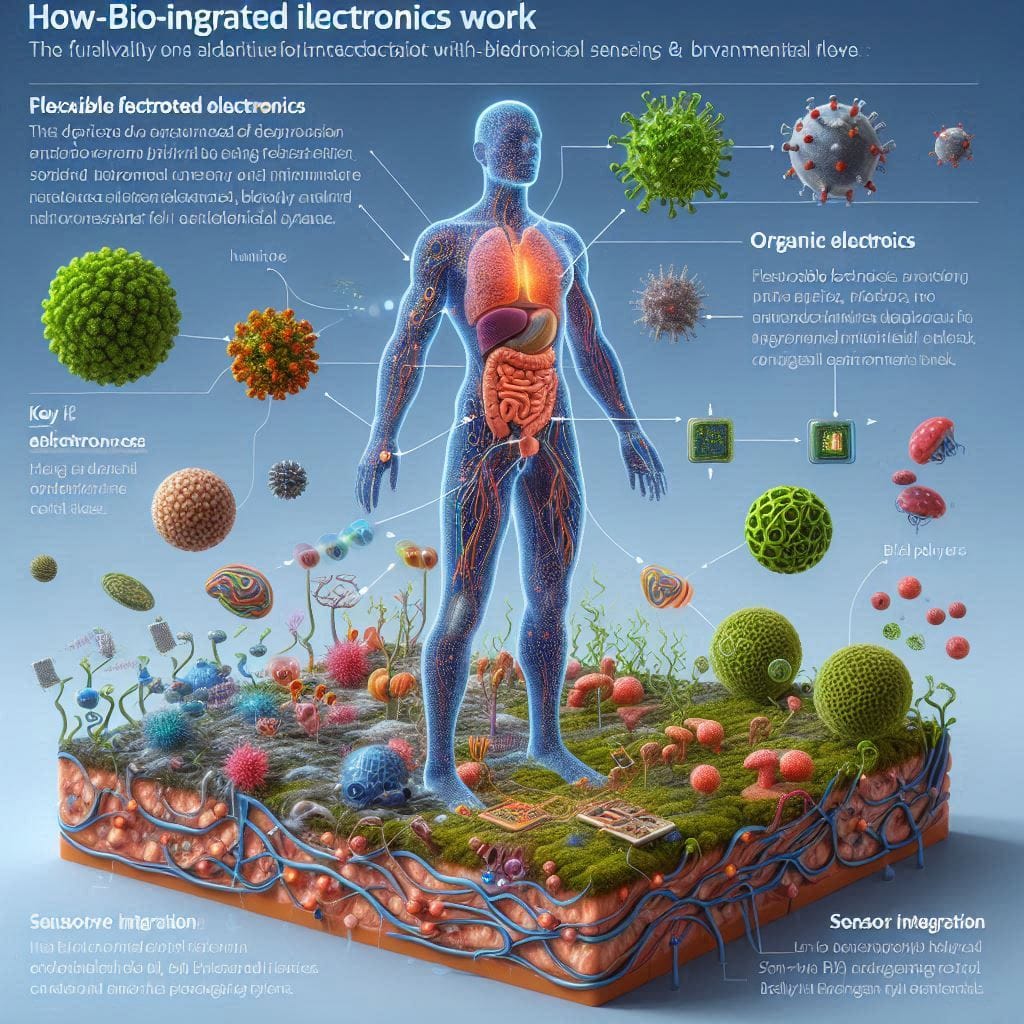
Defining Features
- Flexibility: Enables devices to conform to curved or moving surfaces, enhancing durability and user comfort.
- Durability: Designed to withstand environmental challenges like moisture, temperature fluctuations, and mechanical stress.
- Sensitivity: Highly responsive to minor changes, ensuring precise real-time data collection.
Applications in Environmental Monitoring
By combining the attributes of biocompatible electronic devices with advanced sensing capabilities, bio-integrated electronics have become indispensable in tracking and mitigating environmental challenges. They represent the next frontier in sustainable biosensing technology, empowering humanity to protect and preserve the planet more effectively.
Wearable Biosensors for Environmental Monitoring
Wearable biosensors for environment monitoring represent a significant leap in technology, enabling individuals to detect pollutants such as carbon dioxide (CO2), nitrogen dioxide (NO2), and particulate matter (PM) in real-time. These compact, wearable devices integrate advanced sensing technologies and often utilize IoT-based environmental sensors to provide actionable data.
Detecting Pollutants
- These sensors analyze air quality by measuring harmful gases like CO2 and NO2, particulate sizes (PM2.5, PM10), and even temperature and humidity.
- Using biosensing for pollutants, they ensure continuous tracking of hazardous substances in various environments.
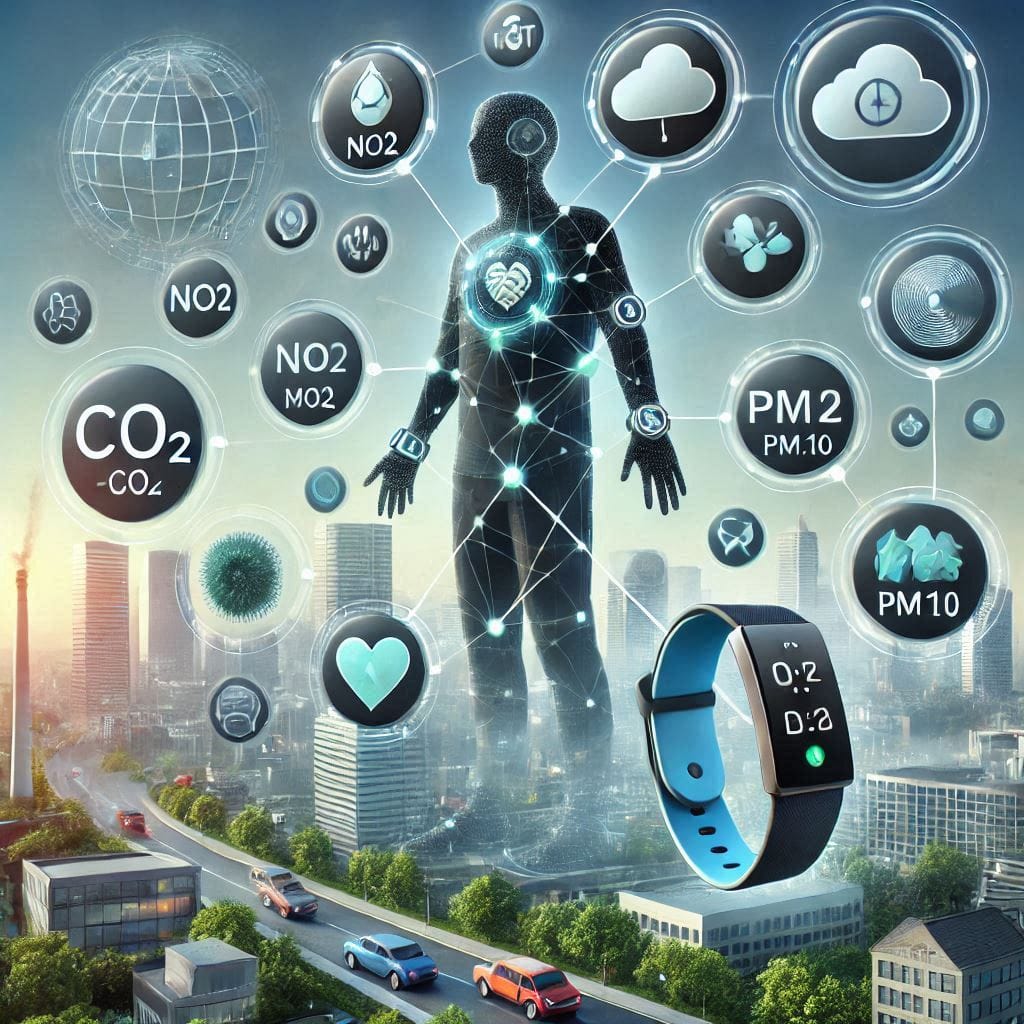
Integration with Wearables
- Devices like wristbands, patches, and smart clothing embed sensors to monitor and report pollutant levels via connected applications.
- Advanced smart environmental monitoring devices often pair with smartphones, providing users with instant alerts and environmental insights.
Applications in Urban and Workplace Safety
- Urban Pollution Monitoring:
- Wearables enable individuals to assess air quality in real-time, making them ideal for people in high-traffic or industrial zones.
- Governments and organizations utilize aggregated data from these devices for smarter urban planning and pollution control.
- Workplace Safety:
- Workers in hazardous industries, such as mining and chemical manufacturing, benefit from wearable sensors that detect toxic substances and warn them of unsafe conditions.
Case Studies and Examples
- Personal Pollution Monitors: Devices like Atmotube and TZOA measure air quality and provide insights into CO2 and PM levels for urban dwellers.
- Workplace Wearables: Smart helmets with embedded sensors monitor gas leaks and airborne toxins, ensuring employee safety in industrial settings.
By leveraging IoT-based environmental sensors, wearable biosensors are transforming how individuals and organizations approach pollution detection and prevention.
Biosensing for Pollutants: Tackling Environmental Challenges
Biosensing for pollutants is a revolutionary approach to identifying and mitigating environmental hazards. These devices monitor contaminants across air, water, and soil, ensuring safer ecosystems and human health.
Types of Pollutants Monitored by Biosensors
- Air Contaminants: Detection of CO2, NO2, ozone, and PM levels in urban and industrial settings.
- Water Contaminants: Sensors measure chemical spills, oil residues, and microbial contamination in water bodies.
- Soil Contaminants: Devices analyze heavy metal concentrations and pesticide residues in agricultural areas.
Real-World Applications and Case Studies
- Oil Spill Detection: Biosensors are employed to identify oil pollutants in oceans, aiding in swift clean-up efforts.
- Water Quality Monitoring: Devices like Lab-on-a-Chip measure toxins, pH levels, and bacterial content, ensuring safe drinking water.
- Urban Air Quality: Deployments in smart cities track and mitigate urban air pollution.
Challenges in Deploying Biosensing Technology
- Harsh Environmental Conditions:
- Devices often face degradation due to extreme temperatures, salinity, or prolonged exposure to pollutants.
- Innovations in organic electronics for biosensing are addressing these challenges with robust materials.
- Scalability and Cost:
- Manufacturing and deploying these sensors at scale remains costly, hindering widespread adoption.
- Research in sustainable biosensing technology aims to reduce costs while maintaining performance.
Biosensors powered by environmental monitoring electronics are a critical tool in combating pollution and environmental degradation. By improving their durability and accessibility, these technologies can play a pivotal role in global sustainability efforts.
Flexible and Organic Electronics in Environmental Sensing
Flexible electronics are built using adaptable substrates like polymers, which make them ideal for flexible electronics environmental sensing applications. These materials include:
- Polydimethylsiloxane (PDMS): Known for its stretchability and durability. PDMS enables sensors to maintain performance even under mechanical stress, like bending or twisting.
- Polyethylene Terephthalate (PET): Lightweight, transparent, and widely used for wearable devices and environmental sensors. PET-based sensors are resistant to moisture and temperature variations, critical for outdoor applications.
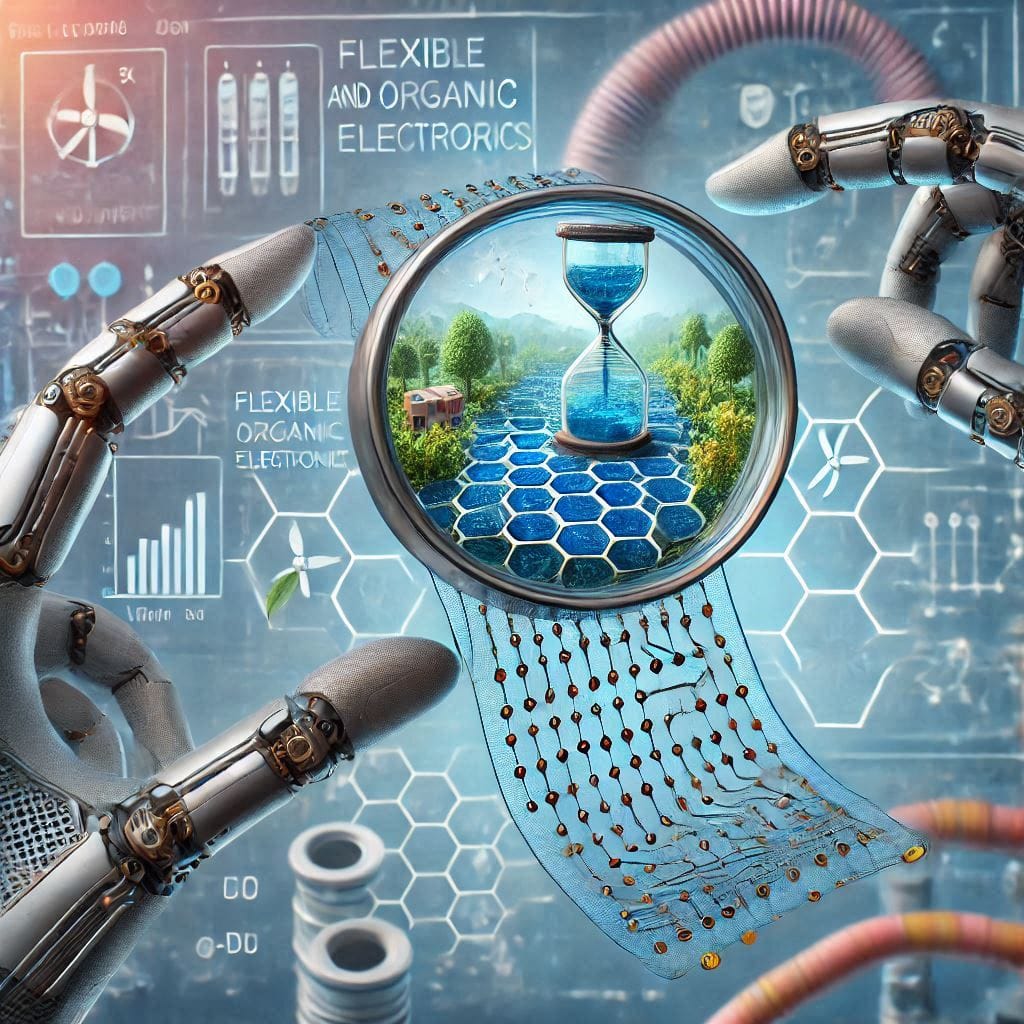
Advantages of Flexible Substrates:
- Improved Adaptability: Flexible materials can conform to non-flat surfaces, making them perfect for integration into wearable devices, fabrics, and other unconventional surfaces.
- Enhanced User Comfort: Their lightweight and soft nature ensures minimal interference with daily activities.
Organic Electronics for Biosensing
Organic electronics, made from carbon-based molecules or polymers, offer a sustainable and efficient way to enhance biosensing technologies. Key features include:
- High Sensitivity: Organic semiconductors can detect minute changes in environmental parameters, such as low levels of CO2, NO2, or particulate matter.
- Eco-Friendliness: These materials often degrade naturally, reducing environmental impact.
- Cost-Effectiveness: Manufacturing organic electronics is cheaper compared to traditional silicon-based systems, making large-scale deployment feasible.
Applications of Organic Electronics:
- Water Quality Monitoring: Detects pollutants like nitrates and heavy metals in real time.
- Air Pollution Sensors: Measures harmful gases, enabling cities to monitor and mitigate urban pollution.
Integration Potential
Flexible and organic electronics have immense potential for integration into a wide array of applications, including:
- Smart Clothing: Sensors embedded in textiles can measure environmental parameters like temperature, humidity, and air quality, offering real-time data to wearers.
- Skin Patches: Biocompatible patches can monitor air quality directly on the skin, providing hyper-localized data.
- Portable Environmental Monitoring Devices: Compact, battery-operated devices equipped with flexible sensors make environmental monitoring accessible for individuals.
Advantages Over Traditional Electronics:
Unlike rigid devices, bio-integrated electronics using flexible and organic components are more adaptable, comfortable, and sustainable, aligning with the needs of a modern, eco-conscious society.
IoT and Bio-Integrated Electronics: The Smart Connection
The Internet of Things (IoT) enables environmental monitoring electronics to collect and transmit data in real time. Key aspects include:
- Data Precision: IoT sensors continuously record environmental variables, ensuring that no critical event goes unnoticed.
- Remote Accessibility: Cloud-based systems allow researchers and policymakers to access data from anywhere, enabling timely interventions.
- Interconnected Networks: IoT connects multiple devices, forming comprehensive environmental monitoring systems for smart cities and industrial applications.
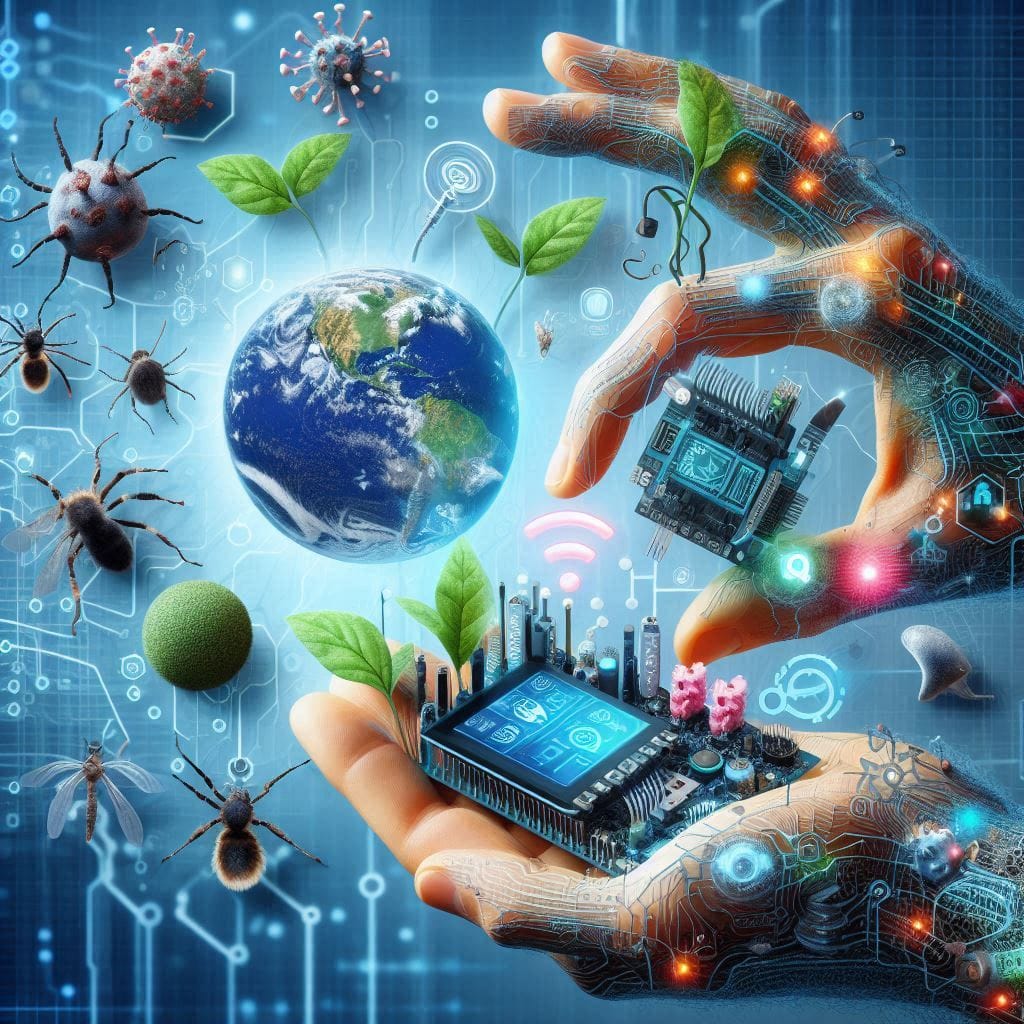
Examples:
- Air Quality Networks: IoT-enabled air quality sensors monitor urban pollution, helping authorities enforce environmental regulations.
- Agricultural Monitoring: IoT-based systems track soil moisture, temperature, and other parameters to optimize crop yields sustainably.
Integration of Bio-Integrated Electronics with IoT
The synergy between IoT-based environmental sensors and bio-integrated electronics enhances the capabilities of environmental monitoring:
- Enhanced Data Analysis: Sensors feed data into IoT systems, which analyze trends and generate actionable insights.
- Scalability: IoT can network thousands of biosensors, making large-scale environmental monitoring projects viable.
- Real-Time Alerts: Integrated systems can trigger alerts when pollutants exceed safe thresholds, preventing disasters.
Future Possibilities: AI and Biosensing Data
Combining AI with IoT-enabled wearable biosensors for environment monitoring opens new avenues for predictive and automated systems:
- AI-Driven Predictions: Machine learning models can identify trends, such as worsening air quality or the likelihood of a pollutant spike.
- Automated Responses: Systems could automatically activate filtration units or notify nearby populations during hazardous conditions.
- Custom Insights: AI can tailor environmental insights for specific industries, such as agriculture, healthcare, or urban planning.
Case Studies and Applications
- Smart Cities: Cities like Singapore use IoT and bio-integrated sensors to monitor air quality, helping reduce pollution through actionable policies.
- Industrial Safety: IoT-based biosensors monitor hazardous gases in factories, ensuring worker safety.
By merging IoT-based environmental sensors with smart environmental monitoring devices, bio-integrated electronics are poised to revolutionize environmental science, making our surroundings safer and more sustainable.
Sustainable Biosensing Technologies: The Path Ahead
Sustainability is at the forefront of modern innovations in bio-integrated electronics. A significant development in this area is the incorporation of biodegradable materials such as:
- Polylactic Acid (PLA): A polymer derived from renewable resources like corn starch, capable of degrading in controlled environments.
- Cellulose-Based Materials: Organic compounds offering flexibility and durability, used in eco-friendly circuit boards.
Advantages of Biodegradable Electronics:
- Reduced E-Waste: These materials break down naturally, preventing the accumulation of toxic waste in landfills.
- Lower Carbon Footprint: The manufacturing process relies on renewable resources, reducing greenhouse gas emissions.
Energy-Efficient Designs and Renewable Power Sources
Sustainable biosensing technologies aim to minimize energy consumption and rely on renewable energy sources like:
- Solar Power: Devices integrated with thin-film solar cells can operate independently in outdoor environments.
- Energy Harvesting: Sensors powered by ambient energy, such as motion, heat, or vibrations, eliminate the need for traditional batteries.
- Low-Power Electronics: Innovations in circuit design significantly reduce energy requirements, making devices more sustainable.
Global Initiatives Supporting Eco-Friendly Monitoring
Several organizations and programs promote sustainable biosensing technology for environmental conservation:
- The United Nations Environment Programme (UNEP): Advocates for the adoption of green technologies in pollution control.
- European Green Deal: Encourages the use of eco-friendly materials and devices in monitoring climate and pollution.
- Private Sector Innovations: Companies like BioCarbon Engineering integrate biodegradable sensors into reforestation projects to monitor soil health.
Applications of Sustainable Technologies
- Agriculture: Sensors monitor soil health while naturally decomposing after use, preventing contamination.
- Water Quality Management: Eco-friendly biosensors detect pollutants without contributing to plastic waste.
The advancement of organic electronics for biosensing and smart environmental monitoring devices reflects the increasing importance of sustainability in technology design, setting a benchmark for future innovations.
Challenges in Bio-Integrated Electronics for Environmental Monitoring
One of the primary challenges facing bio-integrated electronics is ensuring durability and reliable performance in diverse environments:
- Environmental Stress: Devices must withstand temperature fluctuations, humidity, and mechanical strain without compromising functionality.
- Device Longevity: Prolonged exposure to pollutants can degrade sensitive biosensors, requiring frequent replacements or recalibration.
Calibration and Accuracy Concerns
Maintaining high accuracy in environmental monitoring electronics is critical:
- Signal Interference: External factors such as electromagnetic noise can distort data from biosensors.
- Frequent Calibration Needs: Biosensors often require regular recalibration to maintain precision, especially in dynamic environments.
Economic and Practical Barriers
The adoption of biocompatible electronic devices and biosensors faces economic challenges:
- High Production Costs: Advanced materials and manufacturing processes remain expensive, limiting widespread use.
- Scalability: Mass production of high-performance devices without sacrificing quality is a significant hurdle.
Interdisciplinary Collaboration
Successful development and deployment of bio-integrated electronics require expertise from multiple fields:
- Engineering: To design energy-efficient circuits and durable devices.
- Biology: For understanding how biosensors interact with living organisms and environmental factors.
- Chemistry: To innovate materials that are both functional and sustainable.
Policy and Regulatory Challenges
Government regulations and policies play a vital role in facilitating the deployment of smart environmental monitoring devices:
- Lack of Standardization: Inconsistent regulations across regions slow the adoption of new technologies.
- Ethical Concerns: Questions about data privacy and the environmental impact of biosensors can impede progress.
Addressing the Challenges
Overcoming these limitations will require:
- Investments in Research: Funding for material science, sensor technology, and environmental applications.
- Collaborative Frameworks: Partnerships between academia, industry, and government to streamline innovation and deployment.
- Public Awareness Campaigns: Educating stakeholders about the benefits and responsible use of biosensing technologies.
While challenges persist, innovations in bio-integrated electronics and related fields are steadily paving the way for more robust, scalable, and eco-friendly environmental monitoring solutions.
Future Trends in Bio-Integrated Electronics for Environmental Sensing
Bio-integrated electronics represent a convergence of biological systems and advanced technology, enabling real-time monitoring of environmental pollutants with unprecedented precision. As the demand for sustainable solutions in environmental monitoring grows, several future trends are emerging that promise to revolutionize this field.
Advances in Nanotechnology for Enhanced Sensitivity
One of the most promising trends in bio-integrated electronics is the application of nanotechnology to enhance the sensitivity and functionality of biosensors. By incorporating nanomaterials like carbon nanotubes, graphene, and quantum dots, researchers are developing biosensors with superior detection capabilities. These nanomaterial-based sensors are not only more sensitive to pollutants such as CO2, NO2, and particulate matter, but they also offer a faster response time, making them ideal for real-time environmental monitoring. The integration of nanotechnology enables the creation of compact, highly efficient devices that can operate in even the most challenging environmental conditions, paving the way for widespread deployment in cities, industrial zones, and remote areas.
Development of Fully Autonomous Bio-Integrated Systems
Another exciting trend is the shift towards fully autonomous bio-integrated systems. These systems combine wearable biosensors for environmental sensing with advanced AI algorithms to monitor pollutants without the need for manual intervention. Such systems are capable of real-time data collection, analysis, and reporting, empowering individuals and communities to take immediate action when pollution levels exceed safe limits. With advancements in IoT-based environmental sensors, these systems will be able to connect with smart city infrastructures, enabling integrated, efficient pollution control on a much larger scale. This could lead to the development of smart environmental monitoring devices that not only detect pollutants but also predict pollution trends and suggest preventative measures.
The Role of Wearable Biosensors in Citizen Science and Public Health Monitoring
The future of environmental sensing is increasingly becoming personal, thanks to wearable biosensors for the environment. These compact, user-friendly devices are capable of monitoring pollutants in real-time and transmitting data to cloud-based platforms for analysis. This technology has enormous potential for citizen science, allowing individuals to participate in environmental data collection, improving public health surveillance, and contributing to a more informed society. By wearing these biosensors, people can track air quality, water quality, and even soil contaminants, providing valuable data that can drive policy changes and help authorities make informed decisions. In the future, wearable biosensors may even become commonplace in everyday life, offering individuals the tools to actively monitor the environment and take action for a healthier future.
Conclusion
As we’ve seen throughout this discussion, bio-integrated electronics hold the key to revolutionizing environmental monitoring. The intersection of biology and technology has paved the way for highly sensitive, real-time monitoring solutions that can detect a wide range of pollutants, from hazardous gases to harmful particulate matter. The development of these environmental monitoring electronics is crucial in addressing global pollution concerns, ensuring a cleaner, more sustainable planet.
These sustainable biosensing technologies not only offer a solution to pollution control but also contribute to the broader goal of environmental sustainability. With bio-integrated electronics, we have the potential to create smarter, more connected environmental monitoring systems that help us make data-driven decisions to mitigate the impact of human activity on the planet.
Moving forward, it is essential that we continue to support research and innovation in the field of biocompatible electronic devices and sustainable biosensing technology. Government policies, industry investments, and public awareness are all key factors in driving the adoption of these groundbreaking solutions. As we look ahead, it’s clear that bio-integrated electronics will play a pivotal role in ensuring the health of both our environment and our communities.
We encourage you to explore more about bio-integrated electronics, sustainable biosensing technology, and environmental monitoring electronics. By staying informed and engaged, we can collectively push the boundaries of what is possible in environmental sustainability. Don’t forget to check out related articles and case studies for deeper insights into how these technologies are already shaping the future of pollution control and environmental management.
Explore More:
1. Sustainable Ammonia Production: Beyond the Haber-Bosch Process
Learn about innovative methods for sustainable ammonia production that aim to overcome the limitations of the traditional Haber-Bosch process. Dive deeper into the topic in Sustainable Ammonia Production: Beyond the Haber-Bosch Process.
2. The Role of Drone-Assisted Pollination in Modern Agriculture
Discover how drones are transforming agriculture by improving pollination efficiency and enhancing crop yields. Explore this cutting-edge application in The Role of Drone-Assisted Pollination in Modern Agriculture.
3. 10 Sustainable Building Materials Revolutionizing Modern Construction
From bamboo to recycled plastics, find out how sustainable building materials are reshaping the construction industry. Learn more in 10 Sustainable Building Materials Revolutionizing Modern Construction.
4. Biochar: Sustainable Soil Solution and Environmental Progress
Uncover the potential of biochar as a sustainable soil solution that enhances crop productivity while combating environmental challenges. Read more in Biochar: Sustainable Soil Solution and Environmental Progress.
5. LIDAR in Environmental Monitoring: A Game Changer for Remote Sensing
Explore how LIDAR technology is revolutionizing environmental monitoring by providing accurate and detailed data for better decision-making. Dive into LIDAR in Environmental Monitoring: A Game Changer for Remote Sensing.
6. Swarm Robotics for Environmental Monitoring
Learn how swarm robotics, inspired by nature, is enabling cost-effective and efficient environmental monitoring solutions. Find out more in Swarm Robotics for Environmental Monitoring.


